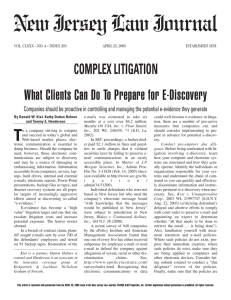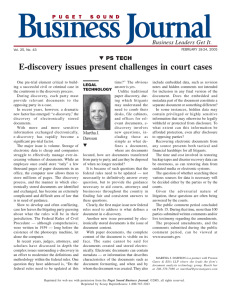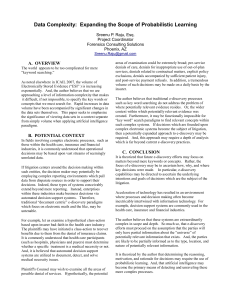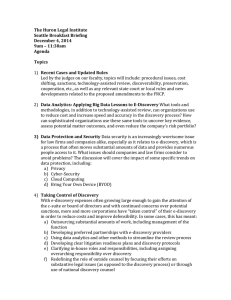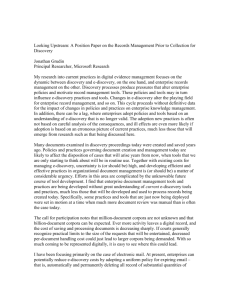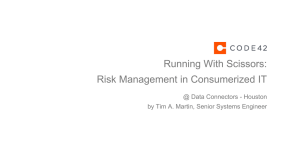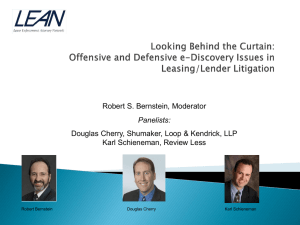Litigation Preparing for E-Discovery — Top 10 Rules
advertisement
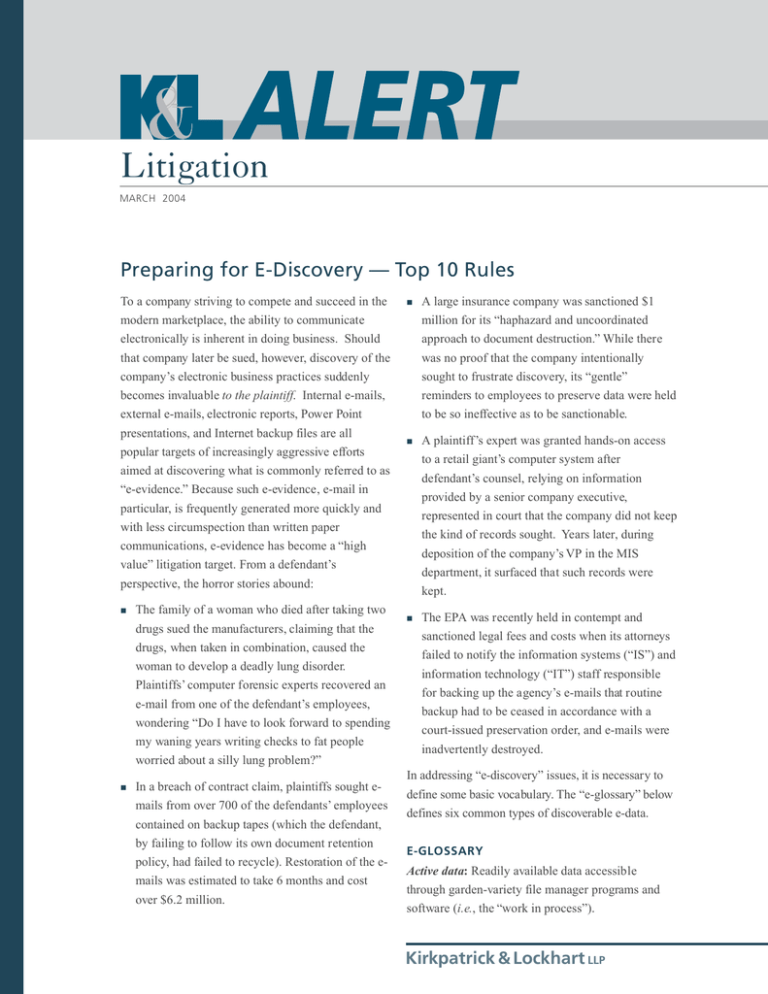
Litigation MARCH 2004 Preparing for E-Discovery — Top 10 Rules To a company striving to compete and succeed in the modern marketplace, the ability to communicate electronically is inherent in doing business. Should that company later be sued, however, discovery of the company’s electronic business practices suddenly becomes invaluable to the plaintiff. Internal e-mails, external e-mails, electronic reports, Power Point presentations, and Internet backup files are all popular targets of increasingly aggressive efforts aimed at discovering what is commonly referred to as “e-evidence.” Because such e-evidence, e-mail in particular, is frequently generated more quickly and with less circumspection than written paper communications, e-evidence has become a “high value” litigation target. From a defendant’s perspective, the horror stories abound: ■ ■ The family of a woman who died after taking two drugs sued the manufacturers, claiming that the drugs, when taken in combination, caused the woman to develop a deadly lung disorder. Plaintiffs’ computer forensic experts recovered an e-mail from one of the defendant’s employees, wondering “Do I have to look forward to spending my waning years writing checks to fat people worried about a silly lung problem?” In a breach of contract claim, plaintiffs sought emails from over 700 of the defendants’ employees contained on backup tapes (which the defendant, by failing to follow its own document retention policy, had failed to recycle). Restoration of the emails was estimated to take 6 months and cost over $6.2 million. ■ A large insurance company was sanctioned $1 million for its “haphazard and uncoordinated approach to document destruction.” While there was no proof that the company intentionally sought to frustrate discovery, its “gentle” reminders to employees to preserve data were held to be so ineffective as to be sanctionable. ■ A plaintiff’s expert was granted hands-on access to a retail giant’s computer system after defendant’s counsel, relying on information provided by a senior company executive, represented in court that the company did not keep the kind of records sought. Years later, during deposition of the company’s VP in the MIS department, it surfaced that such records were kept. ■ The EPA was recently held in contempt and sanctioned legal fees and costs when its attorneys failed to notify the information systems (“IS”) and information technology (“IT”) staff responsible for backing up the agency’s e-mails that routine backup had to be ceased in accordance with a court-issued preservation order, and e-mails were inadvertently destroyed. In addressing “e-discovery” issues, it is necessary to define some basic vocabulary. The “e-glossary” below defines six common types of discoverable e-data. E-GLOSSARY Active data: Readily available data accessible through garden-variety file manager programs and software (i.e., the “work in process”). Kirkpatrick & Lockhart LLP Embedded data: Also known as metadata or “data about data.” Information contained in an electronic version of a document but not apparent on-screen and/or in printed versions (such as data identifying the author, editor, or distribution record of a document). Replicant data: Copies of electronically generated data automatically made and stored in the computer’s hard drive (for example, when a user is creating a Word document, the computer automatically backs up drafts at given intervals; these copies are replicant data). Residual data: Data contained in deleted files that have been removed and “de-indexed” but have not yet been overwritten. When a file is deleted, the computer makes available the space taken up by the old file, but the old file remains until the space is used. Deleted files, as they wait to be overwritten, can be retrieved. Backup data: Information copied to removable media (floppy disks, tapes), which is retained in the event of a system failure, and typically stored in a compressed form at a central location. Backup tapes often take a snapshot of an entire system at a given time, but tend to be unorganized, making it hard to retrieve specific information or documents. Legacy data: Information stored on outmoded media that can no longer be accessed or organized in a format using current software. There are many sources of e-data, including desktops, laptops, PDA’s (personal digital assistants), floppy disks, hard drives, CD-roms, thumb or “jump” drives, magnetic backup tapes, Internet backup files, e-mail and e-mail servers, program files, and voicemail. This non-exhaustive list promises to expand as new forms of data and data storage are created, and as litigants and courts better understand the technology involved. 2 TOP 10 RULES FOR E-DISCOVERY With e-discovery fast becoming a required tool of the modern litigator, any company should prepare in advance by following these Top 10 Rules: Rule No. 1 - Conduct Preemptory Due Diligence. Before you encounter litigation involving e-discovery, learn all you can about how your computer and/or electronic systems are structured and how they actually operate. (If you are technophobic, seek help!) Identify the individuals and/or organizations responsible for your systems and understand their chain of command so you can quickly and effectively disseminate information pertinent to discovery when necessary. Additionally, familiarize yourself with document retention and e-mail policies. Where such policies do not yet exist, propose their immediate creation; where such policies do exist, consider hiring outside counsel to conduct a “due diligence” review before trouble arises. Rule No. 2 - Limit the Creation of E-Data. Now is also the time to brainstorm ways to limit the creation of e-data. These efforts can save time and money while also reducing the volume of data later subject to discovery. E-mail is a good first target since, in 2001, businesses in North America sent an estimated 2.5 trillion e-mail messages, and people tend to write and disseminate things in e-mail that they would never say in person. Consider creating an e-mail policy limiting use to business purposes and educate all personnel about the dangers of overuse, informal use, and misuse of e-mail. If you follow Rule No. 1, and engage IS/IT personnel, they probably can identify other measures to limit the creation of e-data tailor-made to the system that you use. Rule No. 3 - Identify and Protect Confidentiality. Because of the sheer volume of e-data created, maintained, and distributed, it is inevitable that ediscovery often prompts thorny issues of confidentiality. By taking steps now to identify and protect confidentiality, you or your client can avoid future problems and expense. You might require that documents are appropriately labeled in their electronic version and educate staff on how to KIRKPATRICK & LOCKHART LLP LITIGATION ALERT identify e-data as, among other things, confidential, proprietary, privileged, work-product or related to settlement. Or you might create an automatic prompt asking users if they want to add an appropriate label to an e-mail before it is sent. Rule No. 4 - Preserve Potential Evidence. Whether potential evidence has been preserved has emerged as one of the primary focuses of e-discovery. Organizations must create and consistently follow a document retention policy. A sound document retention policy (1) complies with any statutory and/ or regulatory obligations governing the different types of documents to be retained, (2) specifies the length of time each type of document will be retained, (3) establishes a destruction schedule and method of destruction, and (4) provides a detailed protocol for halting the routine destruction of documents in the event of anticipated or actual litigation (i.e., a “litigation hold” or “freeze”). While appropriate management of e-records is beyond the scope of this primer, it is a topic worthy of careful consideration. In light of these preservation issues, it is important to ensure that your client’s IS/IT staff are actually implementing the document/data retention policies that have been adopted. Additionally, in implementing those policies, IS/IT staff should use delete programs that periodically “scrub” or overwrite deleted areas of disks and tapes. Finally, given the current emphasis on obtaining discovery from disaster recovery backup tapes, it is wise to determine the difficulty of restoring data from any such systems currently in use and, if appropriate, to alter those systems accordingly. Rule No. 5 - Anticipate Written Discovery. It is black-letter law that computerized data is discoverable if relevant or likely to lead to relevant evidence. As litigants’ counsel become more educated about the potential evidence that may exist in the realm of e-data, they are making certain that their discovery requests are crafted fully to encompass that realm. For instance, a typical document request defines “document” in the following, extremely broad manner: Some parameters of the obligation to preserve e-data recently were set forth in Zubulake v. UBS Warburg, 2003 U.S. Dist. LEXIS 18771, at *16 (S.D.N.Y. Oct. 22, 2003): “Once a party reasonably anticipates litigation, it must suspend its routine document retention/destruction policy and put in place a ‘litigation hold’ to ensure the preservation of relevant documents.” The obligation to preserve e-data also can be triggered by statutory and regulatory obligations (including the Sarbanes-Oxley Act), court-issued preservation orders, and “preservation letters” sent by litigants to their opponents. Courts have sanctioned litigants who have engaged in intentional, or even innocent, spoliation of e-data by imposing, among other things, monetary sanctions (including the costs and attorneys’ fees associated with discovery motions), preclusion sanctions (i.e., precluding the offer of certain evidence), adverse inferences, default judgments, and so-called “rummaging” (i.e., giving the discovering party “hands-on” access to the respondents’ computer system). MARCH 2004 Any writing, drawing, graphic material, or data compilations, including without limiting the generality of the foregoing, agreements, contracts, notes, work papers, or memoranda, whether stored in tangible, electronic, mechanical, or electric form or representation of any kind (including (i) materials on or in computer tapes, disks, and memory, and (ii) backup copies and “deleted” files on a computer or computer storage device or media) whether located on-site or off-site. All drafts, copies, or preliminary material that are different in any way from the executed or final document shall be considered to be additional documents as that term is used herein. A typical set of interrogatories asks: ■ What specific type of e-mail system and wordprocessing software are used? ■ Who are the individuals responsible for maintaining the systems? ■ How are files stored, protected, and accessed? Kirkpatrick & Lockhart LLP ■ What kind of backup system is used? ■ What are the company’s document retention and e-mail policies? ■ What files are archived? How and where? ■ What access or security utilities are used? ■ Which outside vendors are used and for what? Gone are the days of answering document requests simply by producing paper from file drawers, cabinets, shelves, and storage rooms. Litigants must be prepared for intrusive inquiries into their “eworld,” and it is important to note that e-discovery tends to be retaliatory, with one side responding to ediscovery requests with their own such requests. Defendants should think twice before initiating ediscovery, but once served with e-discovery, should not delay in initiating reciprocal e-discovery as agreements concerning the scope and obligations of e-discovery tend to be easier to negotiate when both sides are facing similar issues. Rule No. 6 - Anticipate Depositions. Deposition requests will likely be directed to key IS/IT personnel, including Chief Information Officers, IS and IT Directors, Network System Administrators, Office Administrators, outside IS/IT Vendors, and records custodians. These individuals can anticipate the same line of questioning identified above in conjunction with anticipated interrogatories, as well as questions pertaining to specific technical issues. Non-IS/IT employees may also be deposed regarding their daily use of an employer’s electronic systems. Rule No. 7 - Understand the Costs. E-discovery differs from traditional paper discovery because edata tends to be more voluminous, harder to retrieve and frequently in need of translation. These characteristics can render e-discovery vastly more expensive than paper discovery and increase the risk that discovery will be used offensively. While it is generally presumed that the responding party bears the costs, where a litigant has requested data that is not readily “accessible,” some courts have been willing to shift or allocate the costs. In Zubulake 4 v. UBS Warburg, 217 F.R.D. 309 (S.D.N.Y. May 13, 2003), the court created a seven-factor test that can authorize cost shifting when “inaccessible” data is sought. In Zubulake, the plaintiff, suing her former employer for gender discrimination, sought e-mail preserved on disaster recovery backup tapes. The fact-intensive test asks, in order of importance: (1) the extent to which the request is specifically tailored to discover relevant information; (2) the availability of such information from other sources; (3) the total cost of production, compared to the amount in controversy; (4) the total cost of production, compared to the resources available to each party; (5) the relative ability of each party to control costs and its incentive to do so; (6) the importance of the issues at stake in the litigation; and (7) the relative benefit to the parties of obtaining the information. Id. at 322. Absent a record to assess the factors, the court ordered the employer to restore and produce responsive documents from a sample of tapes chosen by the plaintiff and to document results and expenses. See K&L Alert “Federal Court Adopts New Test That May Limit Cost-Shifting for E-Discovery” (June 2003). The plaintiff was later ordered to pay 25% of the costs of restoration, and the employer to bear 75% of restoration costs plus all additional costs, including that for privilege review. 216 F.R.D. 280 (S.D.N.Y. July 24, 2003). Rule No. 8 - Find Experts. Computer forensics experts can aid in setting up computer systems, creating and implementing document retention and email policies, searching, collecting and producing edata in response to discovery requests, explaining technical issues to staff, counsel and, if necessary, to a judge, and in protecting the integrity and stability of a client’s computer system during a hands-on search by an adverse litigant. Consider obtaining bids from multiple e-discovery vendors since capabilities and prices vary widely. Rule No. 9 - Keep Current. As the rules for e-discovery are in transition in some jurisdictions, it is critical to monitor legal developments. Five federal district courts and the legislatures and/or courts of KIRKPATRICK & LOCKHART LLP LITIGATION ALERT four states have already amended their procedural rules to address e-discovery. See D.N.J. Rule 26.1; E.D. and W.D. Ark. Rule 26.1; D. Wyo. Rule 26.1(d)(3); M.D. Fla. L.R. 3.03(f); Ill. Supreme Court Rules 201(b)(1) and 214; Md. R. Civ. P. 2-504.3; Ca. Code Civ. P. § 2017; and Texas R.D.P. 196.4 (1999). Additionally, amendments to the Federal Rules of Civil Procedure may be forthcoming. In 2003, the Discovery Subcommittee drafted and recommended proposals in seven areas of concern that were discussed by the full Advisory Committee at a February 2004 conference. The Advisory Committee, however, is still contemplating whether e-discovery is so unique as to warrant separate treatment in the rules. Rule No. 10 - Be Proactive, Not Reactive. Avoid your own horror story by taking steps now to prepare for e-discovery. Kirkpatrick & Lockhart LLP can help you assess and/or create appropriate e-data policies and, where litigation is threatened or pending, provide sophisticated legal counsel in dealing with ediscovery and technology-related issues. THOMAS J. SMITH tsmith@kl.com 412.355.6758 JULIA M. GLENCER jglencer@kl.com 412.355.6318 If you would like to discuss this topic in greater detail, or any other litigation matter, please contact the authors of this article, or any one of the following Litigation Group lawyers: Numerous private organizations, including the American Bar Association and The Sedona Conference (a nonprofit research and educational institute dedicated to the advanced study of law and policy), are studying the pros and cons of rule amendments related to e-discovery and/or proposing their own standards. See ABA Civil Discovery Standards Rules 29 and 30 (1999); Proposed Amendments to the ABA Civil Discovery Standards (released for public comment in Nov. 2003); “The Sedona Principles: Best Practices, Recommendations, and Principles for Addressing Electronic Document Production” (Jan. 2004); The Sedona Principles II: Records Management: Principles and Best Practices for Addressing the Management of Information and Records in a Digital World (anticipated publication in 2004). Boston Mark E. Haddad Dallas Robert Everett Wolin Harrisburg Carleton O. Strouss Los Angeles Paul W. Sweeney, Jr. Miami Daniel A. Casey Newark Anthony P. La Rocco New York Warren H. Colodner Pittsburgh Thomas Smith Julia M. Glencer David R. Cohen San Francisco Edward P. Sangster Washington David T. Case Jeffrey B. Ritter 617.261.3116 mhaddad@kl.com 214.939.4909 rwolin@kl.com 717.231.4503 cstrouss@kl.com 310.552.5055 psweeney@kl.com 305.539.3324 dcasey@kl.com 973.848.4014 alarocco@kl.com 212.536.3912 wcolodner@kl.com 412.355.6758 tsmith@kl.com 412.355.6318 jglencer@kl.com 412.355.8682 dcohen@kl.com 415.249.1028 esangster@kl.com 202.778.9084 dcase@kl.com 202.778.9396 jritter@kl.com ® Kirkpatrick & Lockhart LLP Challenge us. ® www.kl.com BOSTON ■ DALLAS ■ HARRISBURG ■ LOS ANGELES ■ MIAMI ■ NEWARK ■ NEW YORK ■ PITTSBURGH ■ SAN FRANCISCO ■ WASHINGTON ......................................................................................................................................................... This bulletin is for informational purposes and does not contain or convey legal advice. The information herein should not be used or relied upon in regard to any particular facts or circumstances without first consulting a lawyer. MARCH 2004 © 2004 KIRKPATRICK & LOCKHART LLP. ALL RIGHTS RESERVED. Kirkpatrick & Lockhart LLP 75 State Street Boston, Massachusetts 02109 TEL 617.261.3100 FAX 617.261.3175 2828 North Harwood Street Suite 1800 Dallas, Texas 75201 TEL 214.939.4900 FAX 214.939.4949 Payne Shoemaker Building 240 North Third Street Harrisburg, Pennsylvania 17101 TEL 717.231.4500 FAX 717.231.4501 10100 Santa Monica Boulevard Seventh Floor Los Angeles, California 90067 TEL 310.552.5000 FAX 310.552.5001 Miami Center - 20th Floor 201 South Biscayne Boulevard Miami, Florida 33131 TEL 305.539.3300 FAX 305.358.7095 The Legal Center One Riverfront Plaza, Seventh Floor Newark, New Jersey 07102 TEL 973.848.4000 FAX 973.848.4001 599 Lexington Avenue New York, New York 10022 TEL 212.536.3900 FAX 212.536.3901 Henry W. Oliver Building 535 Smithfield Street Pittsburgh, Pennsylvania 15222 TEL 412.355.6500 FAX 412.355.6501 Four Embarcadero Center, 10th Floor San Francisco, California 94111 TEL 415.249.1000 FAX 415.249.1001 1800 Massachusetts Avenue, N.W. Second Floor Washington, D.C. 20036 TEL 202.778.9000 FAX 202.778.9100 ® Kirkpatrick & Lockhart LLP Challenge us. ® 6 KIRKPATRICK & LOCKHART LLP LITIGATION ALERT
